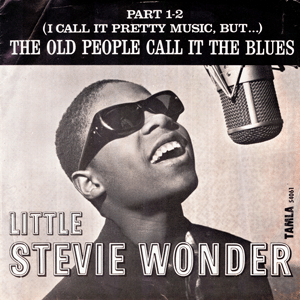Tags
 Tamla T 54061 (A), May 1962
Tamla T 54061 (A), May 1962
b/w I Call It Pretty Music But The Old People Call It The Blues (Part 2)
(Written by Berry Gordy and Clarence Paul)
 The music scene in Detroit in the early Sixties must have been a bewildering place to be. So many great talents coming to the boil all at once – singers, songwriters, musicians, producers – just a great flowering of talent, all seemingly out of nowhere. More often than not, Motown was in position to catch the fruit as it fell from the tree; some of their best talent (the Holland brothers, for instance, or the Supremes) had just turned up one day on Motown’s doorstep.
The music scene in Detroit in the early Sixties must have been a bewildering place to be. So many great talents coming to the boil all at once – singers, songwriters, musicians, producers – just a great flowering of talent, all seemingly out of nowhere. More often than not, Motown was in position to catch the fruit as it fell from the tree; some of their best talent (the Holland brothers, for instance, or the Supremes) had just turned up one day on Motown’s doorstep.
Stevland Morris (né Judkins), an 11-year-old harmonica virtuoso, singer and would-be multi-instrumentalist, didn’t quite just arrive on Motown’s doorstep, but he wasn’t far off; he badgered the brother of Ronnie White (of the Miracles, and also the “Ron” in the short-lived novelty act Ron & Bill) for an introduction to the Motown inner circle; it worked, Berry Gordy so impressed that he supposedly personally coined the stage name Morris continues to use to this day (at the time of writing, Stevie Wonder, now 60, has just finished a triumphant headline set at the 2010 Glastonbury Festival. How’s that for topicality?), though Clarence Paul – Stevie’s writer, producer and general all-round “handler” throughout the early Sixties – has also claimed credit for coming up with the name.
Stevie would go on to record a string of great singles in the Sixties and early Seventies, before wresting creative control of his career from Motown and embarking on a run of stunning original LPs in the mid-Seventies (Music Of My Mind, Talking Book, Innervisions, Fulfillingness’ First Finale, Songs In The Key Of Life) which sold shedloads of copies and – along with the similar creative efforts of Marvin Gaye – completely redefined Motown as a new force in the burgeoning world of artist albums.
It would be easy to say that Motown realised they had something special on their hands back in 1962, that they signed Stevie up on the spot somehow knowing he’d go on to achieve all this (and many have claimed just that), but that’s too simple, and gives Motown far more credit than they deserve. For the first three years of his time with the label, Stevie was treated as little more than a novelty act, only ever a few steps away from being exhibited as some sort of freakshow curio. This single, Wonder’s first record release, is particularly illuminating in that regard.
As a broad rule of thumb, I don’t generally like records performed by children. All too often, a performer’s age is used as an excuse to justify low standards – ahhh, and he’s only nine! – a line of argument which, truth be told, I’ve never understood. I don’t care if a child shows exceptional aptitude for their age. They’re not my kids, I don’t feel the need to coo or applaud or otherwise indulge in weird behaviour that comes across as the equivalent of shoving their talent show ribbons in the faces of other parents. A record is a record; I won’t give it extra credit for being badly sung in comparison to other records just because its singer hasn’t hit puberty yet, just because aw, but look at him dancing, that’s adorable! Bugger off, I have literally millions of other records to listen to that don’t need an asterisk applied before I listen to them.
The problem with the early career of Stevland Morris, to my way of thinking, is that Motown’s promotion efforts mean that it’s difficult to separate the genuinely remarkable from the cringingly tacky. The kid was an undoubtedly gifted harmonica player, a dynamic, infectiously enthusiastic stage performer, just naturally funky… and, of course, blind. All of this stuff got fed through the Motown publicity machine, and the result was “Little Stevie Wonder”, the artist behind the LP The 12 Year Old Genius, and one of the first early forays for Motown into the territory of the artist coming before the record. Indeed, this first single is little more than a calling card, an introduction to a cartoon character – gather round, everyone, and let’s all coo at the adorable blind tween! Because the record’s certainly not remarkable for its music; it might as well have been titled Awwwww! This Blind Kid Is Only Twelve, But He Dances And Plays The Mouth-Organ Like You Wouldn’t Believe!, or something equally patronising.
Stories abound of Motown looking after young Stevie’s development, making sure he kept up with his schooling, trying to shield him from the more salacious aspects of life on the road, supposedly knowing they had something special in their midst etc etc… well, fine, there was money to be made and I’m not for one second suggesting they didn’t really care about Stevie as a person, but if you’d have asked any of the Motown top brass back in 1962 whether they envisaged Little Stevie still being with the company in 1972, whether they really, honestly foresaw him making anything worthwhile from an artistic point of view, never mind becoming one of the best singer-songwriters in America? I doubt it. I really, really do.
Motown had its fair share of young performers – the Supremes and the Marvelettes both featured members not long past their early teens, for instance – but none of them were consciously marketed like this, had their youth and precocious penchant for showbiz pushed front and centre, had their names changed in a patronising bid for publicity.
The name is the first indicator, but even the title just screams “youthful naïveté”, like some sort of conscious attempt to get the awwww!s in from ladies of a certain age. “I call it pretty music, but the old people call it the blues”, Stevie trills, apparently either going along with or unaware of the obvious subtext – “Aww, lookit, he don’t even know what he’s doin!” – a novelty turn and nothing more.
 The picture sleeve (left) portrays Stevie as a miniature Ray Charles, complete with chunky dark glasses, standing on tiptoes to reach a low-hanging mic. He’s been packaged; signed, sealed, delivered, he’s yours (to treasure forever for a low, low price – call now to order).
The picture sleeve (left) portrays Stevie as a miniature Ray Charles, complete with chunky dark glasses, standing on tiptoes to reach a low-hanging mic. He’s been packaged; signed, sealed, delivered, he’s yours (to treasure forever for a low, low price – call now to order).
The record itself just promulgates this performing-monkey schtick. As the liner notes to The Complete Motown Singles: Volume 2 point out, “Part 1” isn’t actually anything to do with the blues at all; it’s a highly generic rock and roll number, Stevie’s weak, uneven vocal telling a story of “playing his harmonica in the normal way” at school and his teachers using the word “blues” which he, of course, doesn’t understand, merely wanting to carry on playing his “pretty music”. His vocal is probably meant to be charming and sweet, but I’m not a middle-aged woman in Sixties America and find it charmless and grating, coming over like a fourth-rate girl group. The best thing about the record, by a mile, is his harmonica playing, which is quite excellent – soulful and well-judged, it’s also the only thing on the record that isn’t dressed up as some cutesy kiddie novelty turn. The rest of it is just Generic Fifties Girl Group Rock Song #815, and need trouble us no longer.
A poor first showing, then, for one of the all-time greats. Other than as a showcase for Stevie’s spectacular harmonica work, it’s really not very good at all.
MOTOWN JUNKIES VERDICT
(I’ve had MY say, now it’s your turn. Agree? Disagree? Leave a comment, or click the thumbs at the bottom there. Dissent is encouraged!)
You’re reading Motown Junkies, an attempt to review every Motown A- and B-side ever released. Click on the “previous” and “next” buttons below to go back and forth through the catalogue, or visit the Master Index for a full list of reviews so far.
(Or maybe you’re only interested in Stevie Wonder? Click for more.)
 |
 |
| The Valadiers “While I’m Away” |
Little Stevie Wonder “I Call It Pretty Music But The Old People Call It The Blues (Part 2)” |


I agree that this is not very good. But, it DID show us that Little Stevie had tonnes of talent.
LikeLiked by 1 person